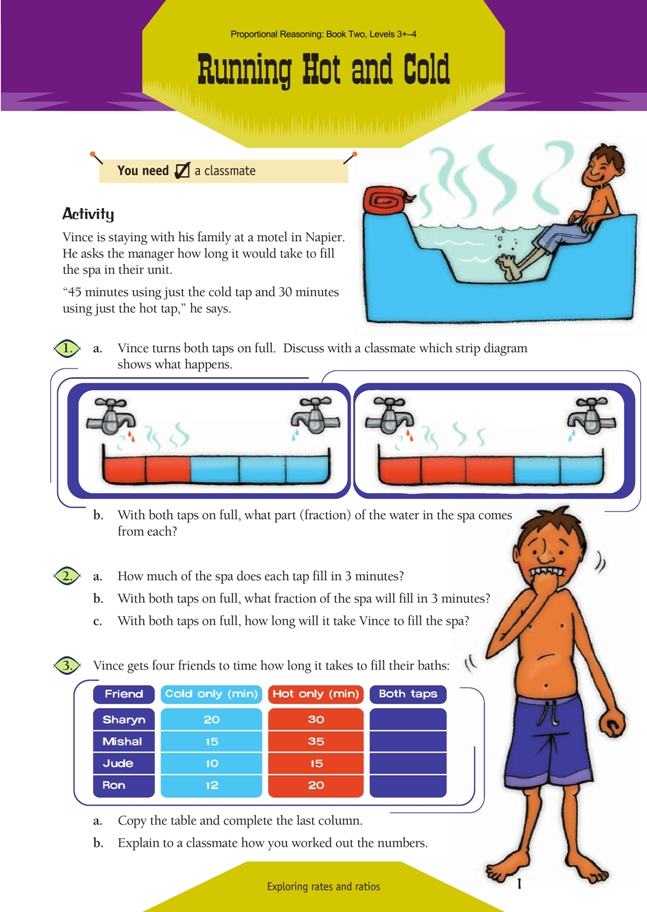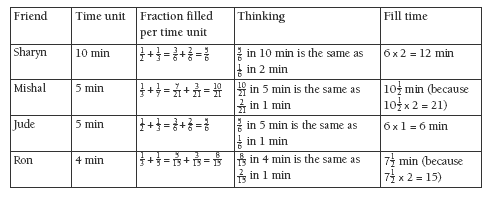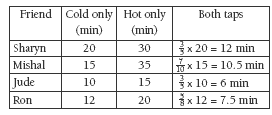This is a level 5 number activity from the Figure It Out series. It relates to Stage 8 of the Number Framework.
A PDF of the student activity is included.
Click on the image to enlarge it. Click again to close. Download PDF (1089 KB)
solve ratio problems in the context of time
solve rate problems
Number Framework Links
Use this activity to:
• help students consolidate and apply their knowledge of equivalent fractions (stage 7)
• develop confidence in students who are beginning to use advanced proportional strategies (stage 8).
A classmate
This activity explores ratio in the context of the time taken to fill a spa. To answer the questions, students need to come to understand the inverse relationship that exists between flow rate and time.
Ask the students to discuss question 1 in pairs and then decide how they might explain their answers in a way that is likely to convince someone else. Get them to report back to the larger group. Make sure that they have an answer for the question “Why is the cold:hot time ratio (3:2) the reverse of the cold:hot volume ratio (2:3)?” If they are not familiar with the concept of inverse relationships, discuss them at this point and get the students to come up with other examples.
The parts of question 2 have been designed to guide the students through a strategy that will lead to a solution for part c. The same strategy can then be used to solve question 3.
Students may find that drawing a double number line for each tap will help them see the relationship between time and water level:
Cold tap only
Hot tap only
Question 2b can be reworded like this: “If the cold tap fills of the spa in 3 min and the hot tap fills of the spa in 3 min, what fraction of the spa fills when both taps run simultaneously for 3 min?” Record and clarify responses until everyone is clear that the equation 1/15 + 1/10 =correctly interprets their strategy. Using number properties: 1/15 + 1/10 = 2/30 + 3/30 = 5/30 = 1/6
For question 2c, ask: “We now know that with both taps running, it takes 3 min to fill of the spa. How can we use this information to work out how long it will take to fill the whole spa?” This is a simple case of direct proportion: the longer the taps run, the fuller the spa becomes. Students could represent the time:fullness ratio using a third double number line or a ratio table:
Go back over the three steps used in question 2. Ask your students why the question told them to use 3 min as a time interval. It is important that they see that this number was chosen because it was a sensible common factor of 45 and 30. (5 min is also a common factor and could be used, but the fraction work involved is a bit more tricky.) You could also challenge the students to write and solve an equation that shows how much of the spa would fill in 1 min with both taps running:
1/45 + 1/30 = 2/90 +3/90 = (= 5/90 = 1/18).
When doing question 3, students can use the same steps that were modelled in question 2. They will need to decide for themselves what sensible common factor they should use for each bath. Suitable factors are: 10 (Sharyn), 5 (Mishal), 5 (Jude), and 4 (Ron). Because the Answers use a different strategy, the calculations are set out here for your convenience:
Answers to Activity
1. a. The right-hand diagram shows what happens. The hot tap fills the spa in less time than the cold tap, which means that the hot water flow rate is greater than the cold water flow rate. So if both are on full, more of the water in the spa will come from the hot tap.
b. 3/5 from the hot tap and from the cold tap.
2. a. The cold tap fills 3/45 = 1/15 of the spa. The hot tap fills 3/30 = 1/10 of the spa.
b. 1/6. (1/15 +1/10 = 2/30 + 3/30 = 5/30 = 1/6)
c. 18 min. (6 x 3 min)
3. a.
b. Explanations will vary, but they will all involve ratio. You could use the same method as for question 2 above. This strip diagram shows the ratios:
The method used to complete the table above goes like this (using Sharyn’s bath as an example): Using ratio to compare the time taken, we get 20:30 = 2:3. Reverse this ratio to compare flow, and we have 3:2. (The cold takes less time because it flows faster.)
This means that 3/5 of the water in the full bath will have come from the cold tap (and
2/5 from the hot tap). We know that if the cold tap is running by itself, it will fill the
bath in 20 min, so if it is just running for long enough to fill 3/5 of the bath, it must take 3/5 x 20 = 12 min.






